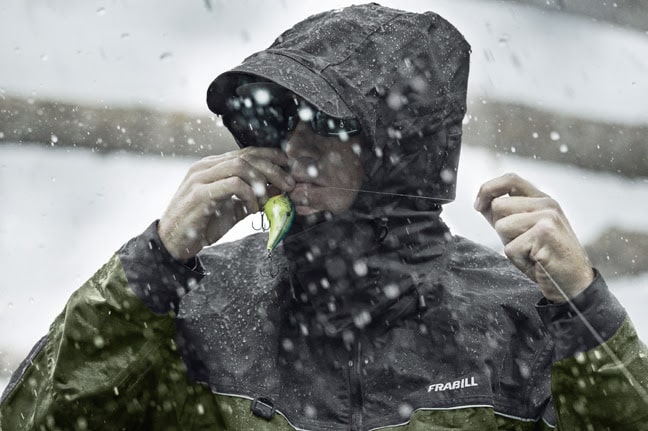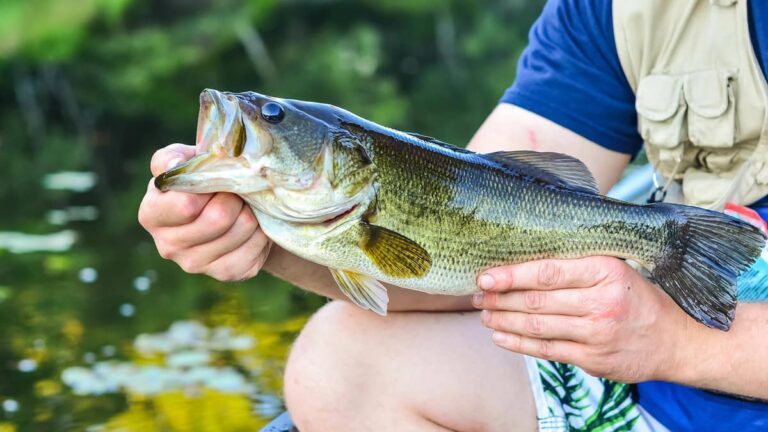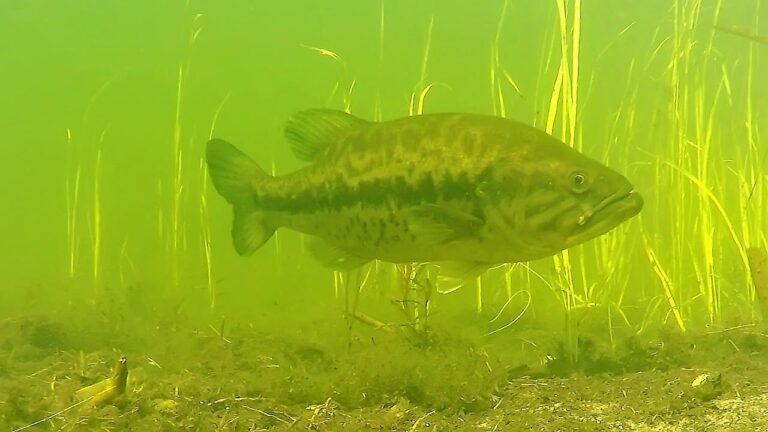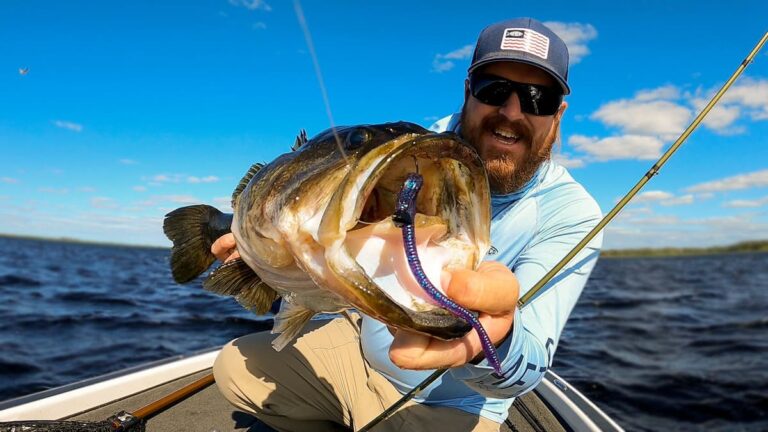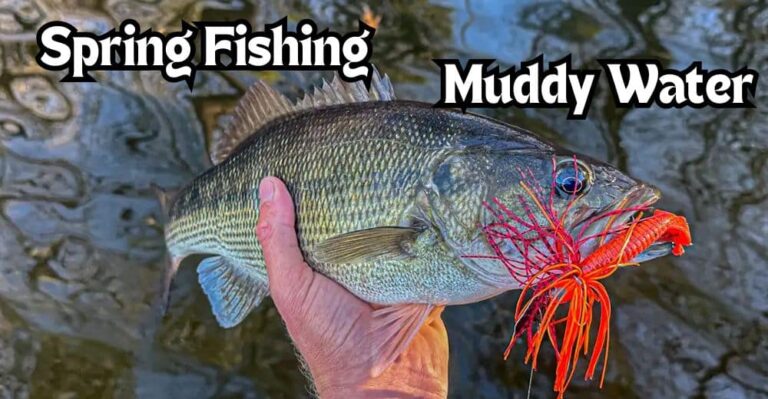Ned Rig Fishing for Bass: A Go To Way to Catch Bass
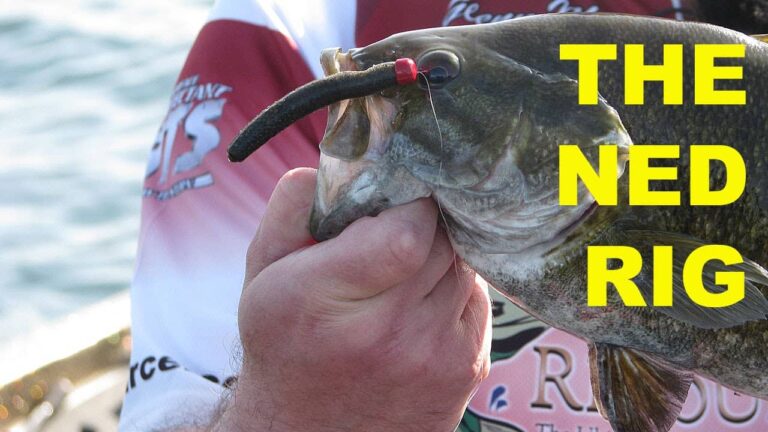
The Ned rig is a go to fishing technique when bass are not biting.
In this article, we’ll explore everything you need to know about this fantastic technique, from understanding its components to mastering the right techniques for success.
Ned Rig Setup
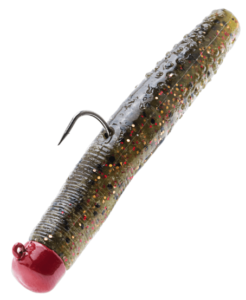
So, what exactly is the Ned rig? Well, think of it as a finesse technique that’s gained quite a reputation among bass anglers.
The Ned rig consists of a few key components that work together to entice those elusive bass. Here’s a rundown of what you’ll need:
- Hooks: You’ll want to go for a small, light-wire Ned rig hooks that can securely hold your bait without overpowering it. A size 1 or 2 hook is usually the way to go.
- Weights: The Ned rig typically uses mushroom-shaped weights, also known as “Ned heads” or “Ned Rig Jig Heads”. These weights are designed to keep your bait close to the bottom, mimicking a natural prey that bass find hard to resist.
- Soft Plastic Baits: The star of the show! Soft plastic baits like stick worms, finesse worms, or creature baits are popular choices for the Ned rig. These baits have a realistic feel and movement that bass simply can’t resist.
That’s the basic gist of the Ned rig’s components. With these simple elements, you’ll be ready to hit the water and start enticing those bass to strike.
Advantages of Ned Rig for Bass
Now, you might be wondering what makes the Ned rig so special and why it’s gaining such popularity among bass fishing enthusiasts.
Well, let me fill you in on its advantages and why it’s worth giving a shot!
- Finesse: This technique shines when the bass are being a bit more finicky or when you’re fishing in heavily pressured waters. The subtle presentation of the Ned rig, combined with its realistic soft plastic bait, can trigger even the most reluctant bass into biting.
- Versatility: It works wonders in various fishing scenarios, from clear lakes to muddy ponds and everything in between. Whether you’re targeting largemouth or smallmouth bass, this technique has proven to be effective across different species and water conditions.
- Simplicity: You don’t need a ton of fancy equipment or complicated setups. With just a few key components and a basic understanding of the technique, you can hit the water and start catching bass. It’s a straightforward approach that delivers results.
- Efficiency: Its compact size and weight make it easy to cast and retrieve, enabling you to explore different areas and find those hidden hotspots where bass are lurking. It’s a fantastic technique for covering a lot of ground and maximizing your chances of hooking into some quality bass.
Equipment for Ned Rig Fishing
When it comes to Ned rig bass fishing, here’s the equipment you’ll need:
A. Fishing rod and reel: Opt for a lightweight, sensitive spinning rod around 6 to 7 feet in length, paired with a smooth drag spinning reel.
B. Fishing line: Choose fluorocarbon line for its low visibility and sensitivity. Aim for 6 to 10 pounds, or use 10 to 15-pound braided line with a fluorocarbon leader.
C. Terminal tackle: Grab mushroom-shaped Ned heads weighing 1/16 to 1/8 ounces, along with small, light-wire hooks (size 1 to 2) for optimal presentation and hooksets.
How to Fish a Ned Rig
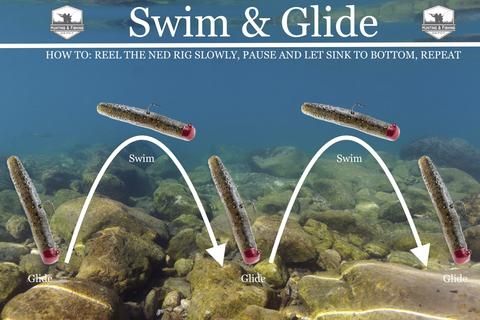
Now, let’s talk about how to work the bait effectively to entice those bass with your Ned rig. Mastering the right technique can make all the difference in attracting strikes. Here are some tips to help you work the bait like a pro:
- Cast and Let it Sink: After casting your Ned rig, allow it to sink to the desired depth. This is where the lightweight mushroom-shaped weight shines, as it will help the bait descend slowly and maintain a natural presentation.
- Lift and Drop: Once your bait is on the bottom, start by gently lifting the rod tip to create a subtle hopping motion. This imitates a small creature or injured baitfish. After the lift, allow the bait to fall back to the bottom. Repeat this lift and drop technique, giving the bait a slight pause between movements.
- Dragging and Shaking: Another effective technique is to drag the bait along the bottom with slow, short movements. This mimics a crawling or foraging action, enticing bass to strike. Additionally, you can add occasional shakes or twitches to create subtle vibrations and attract attention.
- Vary the Retrieval Speed: Experiment with different retrieval speeds to see what the bass prefer on a particular day. Sometimes a slow crawl works best, while other times a slightly faster retrieve can trigger more aggressive strikes. Be observant and adjust your speed accordingly.
- Pay Attention to Bottom Contact: Maintain awareness of the bottom structure and texture. Often, bass will strike when the bait makes contact with objects like rocks, vegetation, or submerged structures. This sudden change can trigger a reaction bite, so be prepared to capitalize on it.
- Stay Mindful of Water Temperature: Bass activity can vary based on water temperature. In colder conditions, slow down your retrieve and focus on precise movements. As the water warms up, you can experiment with slightly more aggressive presentations to trigger a reaction.
Remember, finesse is key with the Ned rig. Keep your movements subtle and let the realistic action of the soft plastic bait do the work.
Adjustments Based on Water Conditions
When it comes to Ned rig bass fishing, adjusting your presentation based on water conditions can greatly improve your chances of success. Let’s explore some tips on how to adapt to different scenarios:
- Clear Water: In clear water, bass can be more cautious and easily spooked. Opt for natural-colored soft plastic baits that closely resemble the forage in the area. Additionally, use lighter line and finesse techniques, as bass can scrutinize the bait more closely. Slow and subtle movements are key to entice strikes in these conditions.
- Murky Water: In murky or stained water, bass rely more on their lateral line to detect prey. Choose brighter or more contrasting colored soft plastic baits to enhance visibility. Increase your retrieve speed slightly to help bass locate the bait through vibrations and noise. You can also try using rattling or scented baits to attract attention.
- Vegetation and Cover: When fishing in areas with heavy vegetation or cover, adapt your presentation to avoid snags and entice strikes. Texas rigging your Ned rig can help prevent snagging in thick vegetation, while a weedless Ned rig setup with a hook and bait that rides upright can minimize hang-ups. Focus on casting near the edges of vegetation or pockets within the cover to target active bass.
- Deep Water: When fishing in deeper water, adjust your Ned rig by using heavier weights to ensure it reaches the desired depth. Allow the bait to sink for a longer duration before starting your retrieve. Consider a slow dragging technique to keep the bait in the strike zone for a longer period and entice those deep-water bass.
- Shallow Water: In shallow water, especially during the spawning season, bass can be more protective and territorial. Opt for smaller soft plastic baits and lighter weights to mimic prey or intruders. Work the bait slowly and meticulously around beds or potential hiding spots to trigger defensive strikes.
- Changing Conditions: Always stay aware of changing weather conditions and adjust your presentation accordingly. Bass can become more active during cloudy or overcast days, so you might experiment with faster retrieves or more aggressive movements. In contrast, on bright, sunny days, finesse techniques and slower presentations often yield better results.
Location and Seasonal Considerations
- Prime Bass Fishing Locations: Identifying the right locations is key to a successful Ned rig bass fishing outing. Focus on areas with potential bass hangouts, such as points, drop-offs, submerged structures, and vegetation edges. These areas provide cover and ambush points for bass as they search for prey. Additionally, pay attention to areas with current flow or areas where baitfish are abundant, as bass tend to congregate in these spots.
- Seasonal Variations: Bass behavior changes with the seasons, so adjusting your approach accordingly is crucial. Here’s a breakdown of seasonal considerations:
- Spring: During the pre-spawn and spawn periods, target shallower areas near spawning grounds. Slow presentations around bedding areas can trigger defensive strikes. As the season progresses, focus on transition areas as bass move to deeper water.
- Summer: Look for cooler, shaded areas, and fish deeper water. Focus on offshore structures, ledges, and drop-offs. Bass may also suspend in open water, so consider vertical presentations with the Ned rig.
- Fall: Bass become more active and feed aggressively in preparation for winter. Target shallower areas as they chase baitfish near shorelines, points, and vegetation. Fast-paced presentations can mimic fleeing baitfish and trigger feeding responses.
- Winter: Bass become lethargic and seek deeper, more stable water. Slow presentations around deep structures, such as humps or channels, can entice bites. Downsize your bait and work it slowly to entice sluggish bass.
Tips for Success with the Ned Rig
- Opt for finesse: The Ned rig excels in finesse fishing situations, so keep your movements and presentations subtle and natural.
- Pay attention to line sensitivity: Fluorocarbon line provides better sensitivity to detect subtle bites, while braided line with a fluorocarbon leader offers strength and sensitivity.
- Experiment with bait colors: Try different soft plastic bait colors to match the forage or to create contrast in varying water conditions.
- Vary your retrieve: Mix up your retrieval speed, incorporating lifts and drops, dragging, and shaking to find what triggers the most bites.
- Be patient and observant: Bass may take their time to strike the Ned rig, so maintain patience and be watchful for any subtle signs of interest or movement.
- Downsize your bait: When faced with tough conditions or pressured fish, downsizing to smaller soft plastic baits can entice more bites.
- Focus on transition areas: Look for areas where bass move between shallow and deep water, such as points, drop-offs, and channel edges.
- Fish during low light conditions: Early morning, late evening, or cloudy days can enhance your chances of success, as bass may be more active and less cautious.
- Keep a light touch: Due to the light-wire hooks used in the Ned rig, maintain a gentle hookset to avoid pulling the bait away from the bass’s mouth.
- Stay versatile: Adapt your tactics based on changing conditions, adjusting your bait color, retrieve speed, and location to stay one step ahead of the fish.
Best Soft Plastic Ned Rig Baits

Ah, the best part: choosing the best soft plastic baits for your Ned rig bass fishing adventures!
There’s a wide variety of options out there, each with its own unique appeal to those hungry bass. So, let’s dive in and explore some top contenders:
1. Stick Worms
These slender, elongated baits are classic choices for the Ned rig.
Their subtle action and slim profile mimic a variety of natural prey, making them highly effective.
Choose colors like green pumpkin, watermelon, or natural browns for versatility.
2. Finesse Worms
With their slightly thicker body and enticing tail action, finesse worms are great for imitating smaller baitfish or creatures.
Choose colors like smoke, pearl, or variations of green pumpkin to match the forage in your area.
3. Creature Baits
When you want to make some noise and trigger a reaction bite, creature baits can be excellent choices.
These baits feature appendages, legs, or claws that create vibrations and attract attention.
Try colors like black and blue, green pumpkin, or junebug for their versatility.
4. Crawfish Baits
Crawfish are a favorite meal for bass, and using a Ned rig with a crawfish-style bait can be irresistible.
Look for baits with realistic pinchers, antennae, and lifelike colors such as brown, green pumpkin, or molting patterns.
5. Grubs and Small Swimbaits
These baits provide a slightly more aggressive action in the water, mimicking small baitfish or fry.
They work well when bass are in a more active feeding mode. Choose colors like shad patterns, pearl, or silver for that baitfish appeal.
Common Challenges
- Snags and Hang-ups: Use weedless or snag-resistant hooks and lighter weights to reduce snagging. Apply gentle pressure and try different angles to dislodge your rig.
- Modifying the Rig: Experiment with different soft plastic bait colors, sizes, and scent attractants to adapt to specific fishing scenarios.
- Detecting Subtle Bites: Watch your line closely for twitches or movements. Develop a sense of line tension and set the hook if you feel any suspicious change in resistance.
- Adapting to Changing Weather: Downsize your bait, slow down your retrieve, and focus on finesse during slow or unfavorable weather conditions.
- Patience and Persistence: Stay patient and keep trying different techniques, locations, and presentations. The more time you spend on the water, the better you’ll understand the patterns.
By keeping these tips in mind, you’ll be well-prepared to troubleshoot common challenges and increase your chances of success while Ned rig bass fishing.
Recap of Ned Rig Fishing for Bass
- The Ned rig is a finesse technique that’s gaining popularity in bass fishing.
- Equipment needed includes a lightweight spinning rod and reel, fluorocarbon line, mushroom-shaped weights, and small, light-wire hooks.
- Attach the hooks by inserting them through the bait and securing them in place.
- Work the bait effectively using techniques like lifting and dropping, dragging, and shaking.
- Adjust the presentation based on water conditions such as clarity, vegetation, depth, and seasonal variations.
- Soft plastic baits like stick worms, finesse worms, creature baits, crawfish baits, and grubs are popular choices for the Ned rig.
- Troubleshooting tips include dealing with snags, modifying the rig for different scenarios, detecting subtle bites, adapting to changing weather, and staying patient and persistent.
Letting this Go
Well, there you have it, my fellow anglers! We’ve explored the wonderful world of Ned rig bass fishing from start to finish.
Hopefully, you’ve gathered some valuable insights and tips to take with you on your next fishing expedition.
The Ned rig is undoubtedly a game-changer in the finesse fishing realm. Its simplicity, versatility, and ability to entice even the most cautious bass make it a must-try technique.
By mastering the art of attaching hooks, weights, and soft plastic baits, and working the bait effectively, you’ll be well on your way to reeling in some impressive bass.
Ultimately, Ned rig bass fishing is all about the thrill of the chase, the excitement of feeling that bite, and the satisfaction of landing a prized bass.
So, grab your gear, head out to your favorite fishing spot, and put your newfound knowledge into action.
Whether you’re a seasoned angler or just starting out, the Ned rig offers endless possibilities for a rewarding and enjoyable fishing experience.


